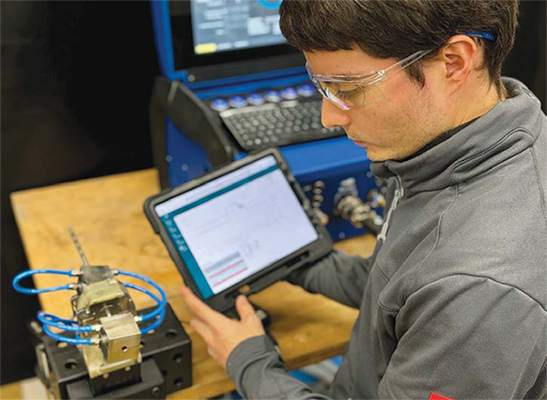Matthias Schaffitz, Application Engineer at Wolfram Industrie, talks about Industry 4.0 and how digitalisation, process automation and programming are increasingly replacing the role of craftsmen in welding applications.
Click to download and read pdf

In order to digitise the welding industry, the welders’ intuition, forged through years of experience, must be translated into logical language.
Although welding technology already collects data metrics such as current, voltage and welding speed, process control and weld quality monitoring still rely heavily on the welder’s expertise. The human ability to flexibly respond to tolerances in the welding joint through a combination of optical pattern recognition and acoustic perception still surpasses the potential of machine systems.
The more automated a welding robot is intended to be, the more complex and precise the preparatory work must be. This means that the intuition developed by welders through years of experience must be translated into a logical machine language.
Interdisciplinary approaches and close, cross-generational communication are essential for making the digitalisation of welding processes truly effective and fully leveraging the potential for higher process stability, resource efficiency, reproducibility and traceability.
A 2024 study by BearingPoint, conducted in collaboration with Munich University of Applied Sciences, found that 100% of surveyed companies in Germany were already engaged in implementing Industry 4.0. However, none had fully completed the transformation: On a scale from ‘not started’ (0) to ‘fully implemented’ (10), all responses ranged between 1 and 8.
Given this background, it is unsurprising that 81% of companies plan to invest in Industry 4.0 in the coming years.
The welding experts at Wolfram Industrie have already observed how challenging this transformation can be in practice. While their customers show great interest in the digitalisation of welding production processes, they also express significant uncertainty about its implementation.
How can production lines be digitalised without replacing all existing machinery and personnel? How should the process chain be designed to remain simple and profitable in day-to-day operations, preventing welders from resorting to manual welding due to system complexity? Most importantly, how can digitalisation be implemented in a way that results in measurable resource savings and efficiency gains?
No data hoarding, but meaningful monitoring
From a technical perspective, purchasing new Industry 4.0-ready systems is easier than retrofitting existing machinery, but such an investment rarely makes financial sense for most companies. Fortunately, even older generation welding machines offer opportunities for data collection, such as monitoring current, voltage, coolant levels, or component movement, for example. However, many sensors, according to common industry standards, lack the high resolution required for detailed monitoring of welding processes.
To track electrode wear, shielding gas effects or gas turbulence, for example, a resolution of more than 1 000 data points per second is necessary. Additionally, standard values such as current and voltage can be difficult to measure in tungsten inert gas (TIG) welding, as the high-voltage ignition used requires specially designed arc voltage measurement systems.
Yet, even with the availability of high-resolution measuring devices, the key to Industry 4.0 implementation lies in balancing what is measured against how the data can be meaningfully analysed. So, how can this balance be achieved?
Resource efficiency and process reliability
Digital monitoring competes with a highly skilled counterpart: experienced welders and their intuition.
Due to their three-dimensional spatial awareness, humans can quickly recognise optical patterns and acoustic anomalies. This enables experienced welders to react flexibly, compensating for tolerances in the weld seam and making them less dependent on precise pre-processing.
The more automated a welding process becomes, however, the more meticulous and precise the preparation must be. The increased setup time has led to the perception that digitalised welding processes are only worthwhile for high production volumes.
However, time is not the only resource significantly impacted by welding digitalisation. Automated processes can also reduce material waste, as fewer rework operations are needed, and a consistently high quality is easier to replicate. Given that metals are resource-intensive and costly materials, efficiency and process stability gains can become evident even in small-scale production. The prerequisite for this is correct machine settings and minimal production tolerances. In other words, the expertise and professional intuition of welders must be translated into a logical, programmable language.
Linking human expertise with digital information flow
At this point, two different information flows collide: that of craftsmen and that of programmers. This also raises a generational question, as traditional manual welders tend to belong to an older demographic, while operators are generally younger.
To effectively merge the deep knowledge of traditional craftsmanship with the rapid data flow from real-time monitoring, the prevailing distrust between both groups must be overcome. Traditional welders would benefit from gaining an understanding of digital data processing and process control, while operators and programmers should strive to grasp the principles of the welding trade.
The key to a successful digital transformation in welding technology lies in communication and the methodological competence of both sides. To support its customers in this transition, Wolfram Industrie collaborates closely with research institutes, system manufacturers and end users. The initial goal is to establish the necessary foundations for each production environment to assess relevant data and establish realistic monitoring capabilities. Based on this, the effort required for pre- and post-processing of workpieces in automated welding processes can be optimised, setup times minimised, and resource consumption in daily operations reduced – ensuring that the vision of higher process stability, resource efficiency and traceability promised by Industry 4.0 does not remain an empty promise.